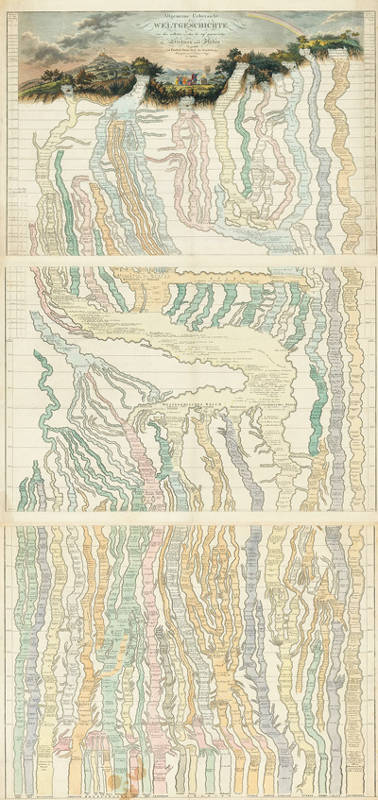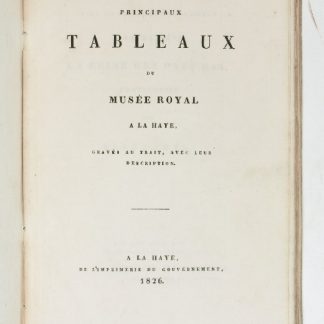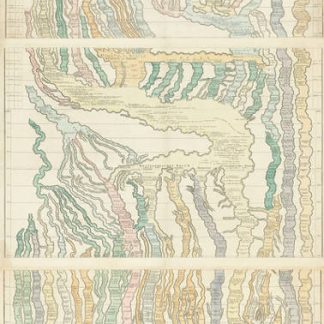Time Chart - History of Great Nations
Allgemeine Uebersicht der Weltgeschichte von den aeltesten Zeiten bis auf gegenwärtige in Strömen und Flüßen dargestellt von Friedrich Strass.
Copper engraving with full original colour, in 3 unjoined sheets. Each sheet 47 × 71 cm. Very good condition, lovely original colour, mild toning, small nicks in blank margins and light stains in lower area.
€ 6.500,00
A very rare edition of Strass's large and resplendently coloured time chart depicting the inter-connecting streams of the histories of different World civilizations and nations from 3984 BC up to 1830. This large and colourful time chart employs ingenious visual methods to graphically illustrate historical events. The history of the world is presented as interwoven streams featuring the stories of its great civilizations/nations weave their way down the time chart like the paths of streams. History is shown to commence with Genesis, which is shown here to have occurred in 3984 BC, a date close to that asserted by the Ussher Chronology. This theory as to the timing of Genesis (which was said to have occurred in 4004 BC) was devised by James Ussher (1581-1656), the Archbishop of Armagh and the Primate of All Ireland (in office 1625-56), and is based on his "literal reading" of the Bible. The Ussher Chronology gained widespread popularity in certain Protestant circles during the 19th century. The time line starts at the top of the composition with the great ancient civilizations, namely, the Italians; Greeks; Asia Minor; Assyrians; Syrians; Phoenicians; Jews; Egyptians and the Chinese. Down the various streams are plotted the names and dates of different eras and rulers. The stream on the furthest right details major world events. Part way down, the civilizations in the Western and Mediterranean world converge into the 'Roman Empire' before splintering again into various new entities. The streams then continue to weave, combine and separate, mitigated by the interconnecting streams of major events and characters, towards the bottom of the time line, where the individual streams are represented by the nations and regions of Denmark; Sweden; Russia; the German States; Austria; Holland; Switzerland; France; the Italian States; States of the Church (Papal States); Spain; Great Britain; Greece; Persia; and China. William Bell, who issued his own version of the time chart in London in 1849, described the merits of Strass's conception to the study of history: "However natural it may be to assist the perspective faculty, in its assumption of abstract time, by the idea of a line [...] it is astonishing that [...] the image of a Stream should not have presented itself to any one [...] The expressions of gliding, and rolling on; or of a rapid current, applied to time, are equally familiar to us with those of long and short. Neither does it require any great discernment to trace [...] in the rise and fall of empire, an allusion to the source of a river, and to the increasing rapidity of a current, in proportion with the declivity of their channels towards the engulfing ocean. Nay, the metaphor [...] gives greater liveliness to the ideas, and impresses events more forcibly upon the mind, than the stiff regularity of the straight line. Its diversified power likewise of separating the various currents into subordinate branches, or of uniting them into one vast ocean of power [...] tends to render the idea by its beauty more attractive, by its simplicity more perspicuous, and by its resemblance more consistent" (Rosenberg & Grafton, pp.143 & 147). The present time chart is derived from Strass's exceedingly rare "Strom der Zeiten" ("Stream of Time", 1804). Strass's work proved to be highly influential and was widely copied in both Europe and America, and translated into several languages, including Russian. All of the large German editions are very rare, and the present example, in unjoined sheets with resplendent original colour, is an especially fine example.
Cf. OCLC (Re: 1818 Zanna ed.) 165398011. (derivative 1849 London ed.). Daniel Rosenberg & Anthony Grafton, Cartographies of Time, pp. 143f. & 147, fig. 4:45.






